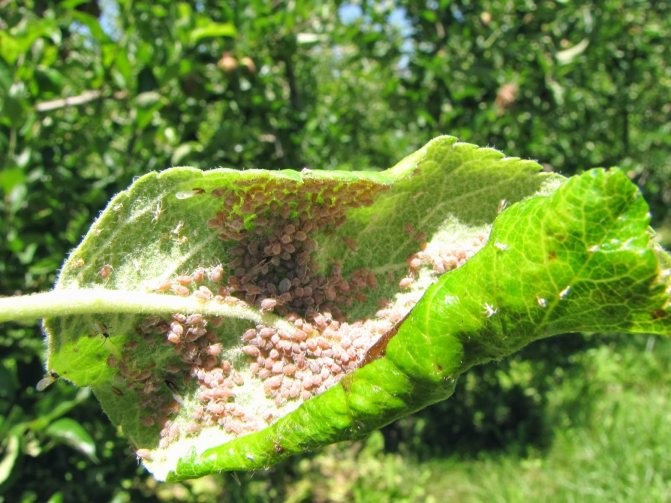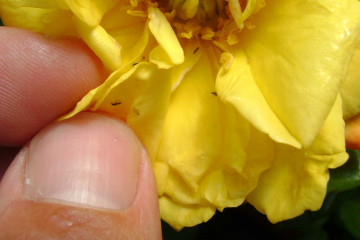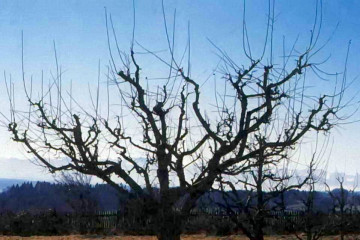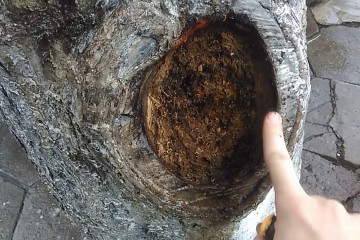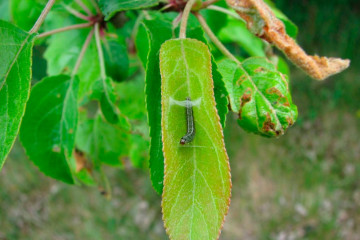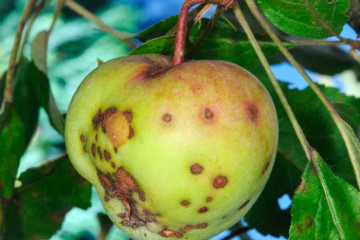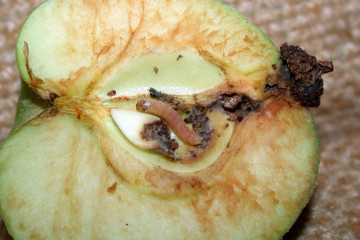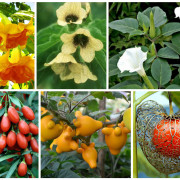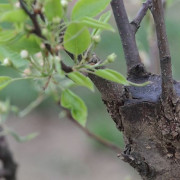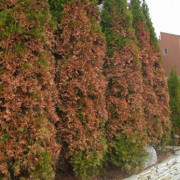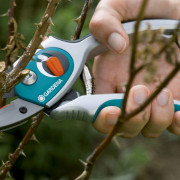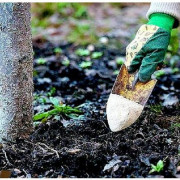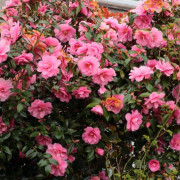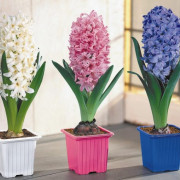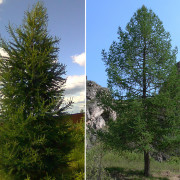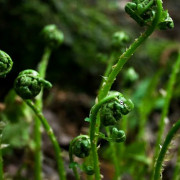Aphids on an apple tree: how to get rid of folk remedies
Content:
- Pest signs
- Causes of the appearance of aphids
- Why aphids are dangerous for an apple tree
- In what period to fight against aphids
- Mechanical methods of struggle
- Traditional methods of getting rid of aphids on an apple tree
- Biological agents
- Chemicals against aphids on an apple tree
- How to prevent contamination of neighboring trees
Aphids are insect pests of a wide range of agricultural crops from the Homoptera order, the Aphididae family. More often they parasitize on two crops, of which the main one is an apple tree, the intermediate one is grasses or vegetables. Insects are very fertile. They give from 6 to 19 generations per year. The main harm to apple trees is a significant weakening of the growth and development of trees, which affects a decrease in yield and fruit quality. To eliminate the pest in the entire garden, it is important to understand how to properly deal with aphids on an apple tree.
Pest signs
The main feature is the presence of individuals on the tops of young shoots, the underside of leaves, which can curl, wrinkle, curl and bubble. Features of external manifestations depend on the type of insects that have settled.
On an apple tree in the temperate zone of our country, at least 4 species of aphids parasitize, and there are about 5 thousand of them in the world. Generations of pests look different, they have winged and wingless individuals.
The main parasites of the apple tree:
- Green apple aphid - the founding female has a green body, a brown head, the winged settler females are green with black legs and a head. Their antennae are yellow, dark at the ends.
- Apple-cereal aphid is a yellowish body, a dark green stripe runs along the back, which turns into transverse lines of the same color at the back. Over the summer, it gives at least 5 generations, it takes about 7 days for each to develop. If the garden has a lawn of bluegrass grasses, this species of aphid moves on to feed on these grasses. Outwardly, it is very difficult to notice pests on the lawn, since they feed on the root collar of plants.
- Red gall aphid (apple gray aphid) - large individuals of dark gray color with a white bloom, gives up to 5 generations per season. The leaves of the apple trees curl downward, become lumpy, acquire a crimson-red or pink color. An apple by the time of ripening may have raspberry spots. This species of aphid has several migratory forms and intermediate hosts in the form of weeds; they are well adapted to survival in the environment.
- Apple-plantain aphid - young pinkish larvae, adults - gray-green with a white wax-like bloom, each is capable of giving offspring of the second generation in the amount of 250 pieces. A characteristic feature is that the leaves of the apple trees are curled across. In the second half of summer, he switches to plantain.
- Pear-cereal aphids - individuals of a red-brown color, when crushed, leave reddish traces, harm on pome breeds. Young shoots after settling turn black and die. A cobweb of mites appears on the branches, which attack the weakened shoots. In July, aphids start feeding on grasses, including lawn grasses.
Causes of the appearance of aphids
Apple and other aphids are endemic to Eastern Europe, many live in the southern regions of our country and the Crimea.These insects parasitize quite a lot on field crops, wild apples and pears, from where they migrate to orchards. Aphids on an apple tree appear for a number of reasons:
- a spontaneous outbreak of the number of pests in a given area due to favorable conditions for overwintering and the development of individuals in spring;
- the presence in the garden of plants - intermediate hosts: bluegrass, fescue, wild oat, rump, wheatgrass, foxtail, currant, gooseberry, raspberry, horse sorrel;
- dispersal of ants in the garden, since they feed on the secretions of aphids (molasses) and transfer individuals to young growth of apple trees.
Ants can also contribute to a favorable overwintering of aphids. They take eggs and founding females to their nests for the winter, and in the spring they carry them out, finding the best feeding conditions for them.
Aphids overwinter at the stage of eggs, which at the end of autumn are laid by females in the cracks and folds of the bark of skeletal branches, individual fruit formations. The older the tree, the easier the pests overwinter on it.
Why aphids are dangerous for an apple tree
The beginning of feeding of individuals coincides with the period of bud opening and the beginning of the growth of young shoots in April and May. By the time of flowering, the founding females are ready to lay off new generations of the pest. Therefore, in June, there is a massive increase in the number of aphids. Due to punctures, the leaves lose their ability to photosynthesis, the tree develops poorly, has a depressed appearance, frost resistance decreases, fruiting stops.
In adult gardens, aphids are carriers of viral diseases and phytoplasma (a group of intracellular parasites). They are especially dangerous for young plants and nurseries. During the summer, there are several outbreaks of aphid numbers. If you do not start to treat, then as a result, this can lead to the oppression of seedlings, when it will no longer be possible to save them.
In what period to fight against aphids
Many gardeners ask the question of what to do from aphids on an apple tree and how to get rid of the pest in a short time. The best time to fight is in the early spring period before bud break. At an air temperature from 0 to +5 degrees, eradicating treatment is carried out. Then it is necessary to spray the trees before flowering to destroy the female founders of the colonies. In the future, when new generations appear, the garden needs to be processed every 2-3 weeks.
Mechanical methods of struggle
You can manually remove a small focus of the pest on one or two plants. If there is only one tree, you can water it with a hose to mechanically wash away insects. An important activity is the weeding of the row spacings, the spaces around the near-stem circles and the removal of near-stem shoots in old gardens. If there are anthills and it is noticed that every year there are foci of aphid development next to them, then chemical methods of fighting ants should be applied.
Traditional methods of getting rid of aphids on an apple tree
If the number of pests is small, in order to remove the outbreak from the site, you need to use folk remedies. To kill aphids and stop the transfer of pests by ants, you can use tobacco dust. Powder is dusted with sticky shoots, stems, route routes of ants 2-3 times a week. To prepare a solution, to sprinkle the curled leaves, you need to take 50 g of powder per 10 liters of water. Wood ash has the same effect.
Another way is to use green soap. Take from 250 to 400 ml in a bucket of water, mix thoroughly with water, spray twisted leaves on all sides, trying to rinse them inside. Work with gloves.
Ammonia mixed with laundry soap paralyzes the activity of insects.To prepare the solution for a bucket of water, you should take 50 ml of alcohol and 50 g of crushed laundry soap. Stir the mixture thoroughly, strain and spray the garden until the trees begin to bloom en masse.
Garlic infusion repels aphids and prevents the spread of the outbreak - chop 5 cloves of garlic in a blender, pour a glass of boiling water, cover, leave for a day. Then add 2 teaspoons of vegetable oil and 1 teaspoon of liquid soap. Rinse the twisted leaves on the shoots with a solution.
Biological agents
In nature, aphids are eaten by ladybugs, ground beetles, earwigs, crickets, and lacewings. A small flower garden in your garden will help attract beneficial insects. From biological products produced by the industry, you can use Fitoverm. An ampoule of 2 ml of the drug should be dissolved in 1.0-1.3 l of water. Consumption per tree from 2 to 5 liters.
Chemicals against aphids on an apple tree
For eradicating spraying, "Preparation 30 Plus" is used. It is based on mineral oils that paralyze the breathing of insect pests. The dosage is 40-50 ml per 10 water.
Means such as:
- "Biotlin" - at a dose of 3 ml per 10 liters of water. Reliable during the growing season with a quick action within a few hours.
- "Clonrin" provides protection for 3-4 weeks, interrupts the chain of reproduction of generations of aphids. It is used in a dosage of 60-100 g per 10 liters of water.
- "Voliam Flexy" is a modern effective preparation, used in a dose of 4-5 ml per 10 liters of water. One treatment is enough for 14-20 days.
- "Cyperus" - a dose of 2-4 g per 10 liters of water. Effective against a wide range of pests, including locusts.
- "Aktara" - the drug is able to penetrate the lower side of the leaf, it is used in a dosage of 3-4 g per 10 liters of water. On early varieties of apple trees, it is necessary to apply before flowering, in later varieties - it is allowed after flowering.
How to prevent contamination of neighboring trees
To protect the garden from the spread of aphids, it is important to follow a set of measures:
- get rid of the pest on diseased trees in time;
- carry out eradication spraying of the entire garden, including berries (raspberries, strawberries, currants, gooseberries);
- to clean the trunks of old trees from peeling bark, whitewash them at the end of winter;
- provide timely protection of lawns and vegetable beds growing nearby, especially where there is horse sorrel, from invasions of aphids and other harmful insects;
- remove shoots growing from the root and on the trunk;
- weed the aisles regularly;
- apply root and foliar dressing for rapid growth of leaves and shoots, coarsening of tissues;
- combine chemical treatments with folk remedies.
Systematic purposeful work to protect the orchard and nursery of seedlings will certainly bring results in the form of well-developed plants, large healthy leaves and fruits with high nutritional properties, because apples are a valuable source of vitamins all year round.
